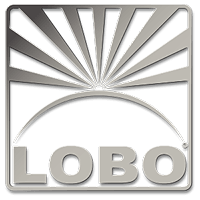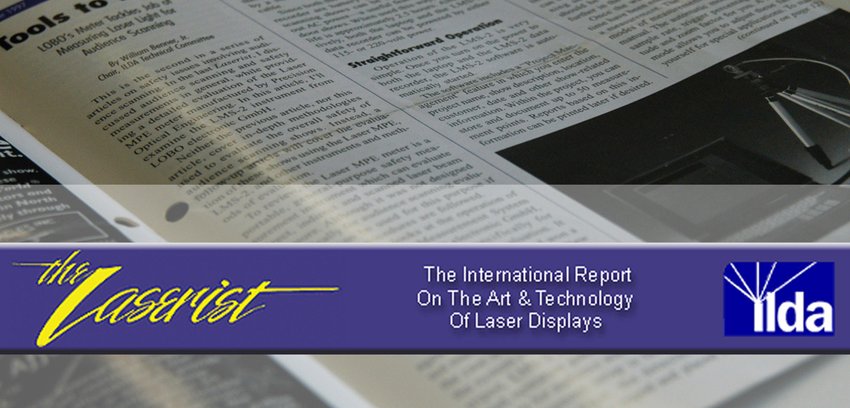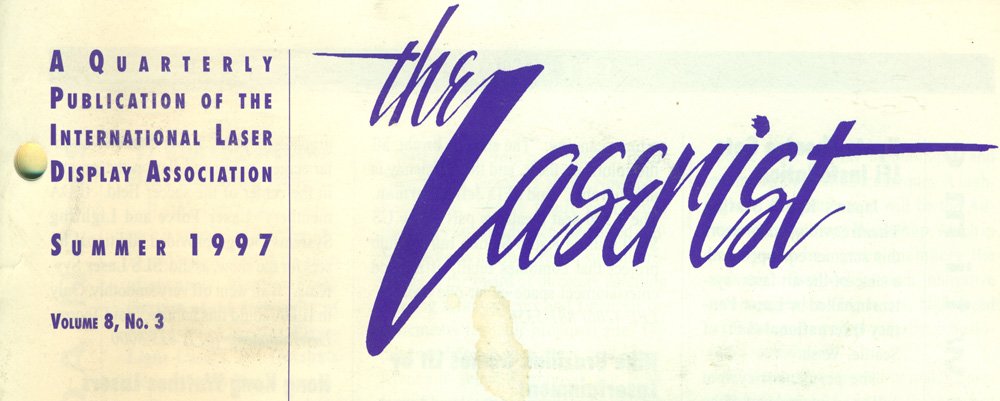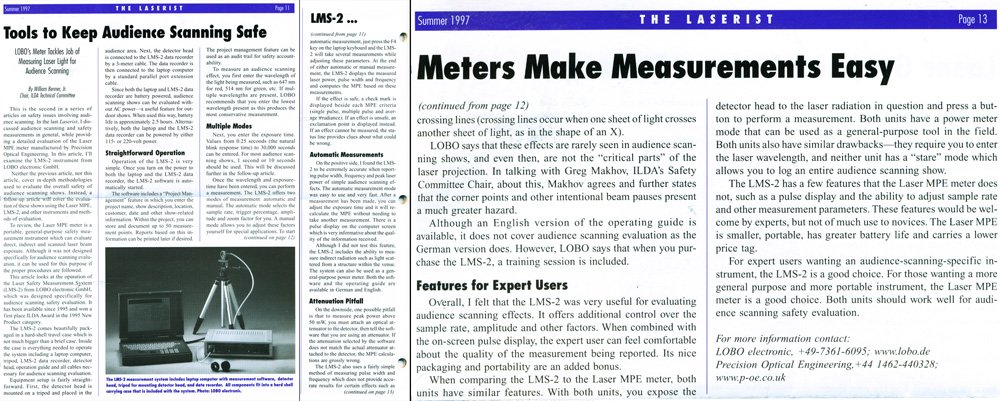
Medienberichte
The Laserist Sommer 1997
"Meters Make Measurements Easy" / "Tools to Keep Audience Scanning Safe"

LOBO's Meter Tackles Job of Measuring Laser Light for Audience Scanning By William Benner, Jt. Choir, ILDA Technical Commitee
This is the second in a series of articles on safety issues involving audience scanning. In the last Laserist, I discussed audience scanning and safety measurements in general, while providing a detailed evaluation of the Laser MPE meter manufactured by Precision Optical Engineering. In this article, I´ll examine the LMS-2 instrument from LOBO electronic GmbH.
Neither the previous article, nor this article, cover in -depth methodologies used to evaluate the overall safety of audience scanning shows. In stead, a follow-up article will cover the evaluation of these shows using the Laser MPE, LMS-2, and other instruments and methods of evaluation.
To review, the Laser MPE meter is a portable, general-purpose safety measurement instrument which can evaluate direct, indirect and scanned laser beam exposure. Although it was not designed specifically for audience scanning evaluation, it can be used for this purpose if the proper procedures are followed.
This article looks at the operation of the Laser Safety Measurement System (LMS-2) from LOBO electronic GmbH, which was designed specifically for audience scanning safety evaluation. It has been available since 1995 and won a first place ILDA Award in the 1995 New Product category.
The LMS-2 comes beautifully packaged in a hard-shell travel case which is not much bigger than a brief case. Inside the ease is everything needed to operate the system including a laptop computer, tripod, LMS-2 data recorder, detector head, operation guide and all cables necessary for audience scanning evaluation.
Equipment setup is fairly straight forward . First, the detector head is mounted on a tripod and placed in the audience area. Next, the detector head is connected to the LMS-2 data recorder by a 3-meter cable. The da ta recorder is then connected to the laptop computer by a standard parallel port extension cable.
Since both the laptop and LMS-2 data recorder are battery powered, audience scanning shows can be evaluated without AC power- a useful fea ture for outdoor shows. When used this way, battery life is approximately 2.5 hours. Alternatively, both the laptop and the LMS-2 data recorder can be powered by either I 15- or 220-volt power.
Straightforward Operation
Operation of the LMS- 2 is very simple. Once you turn on the power to both the laptop and the LMS-2 data recorder, the LMS-2 software is automatically started.
The Software includes a "Project Management" feature in which you enter the project name, show description, location, customer, date and other show-re lated information. Within the project, you can store and document up to 50 measurement points. Reports based on this information can be printed later if desired.
The project management feature can be used as an audit trail for safety accountability.
To measure an audience scanning effect, you first enter the wavelength of the light being measured, such as 647 nm for red, 5 14 nm for green, etc. If multiple wavelengths are present, LOBO recommends that you enter the lowest wave length present as this produces the most conservative measurement.
Multiple Modes
Next, you enter the exposure time. Values from 0.25 seconds (the natural blink response time) to 30,000 seconds can be entered. For most audience scanning shows, 1 second or 10 seconds should be used. This will be discussed further in the follow-up article.
Once the wavelength and exposuretime have been entered, you can perform a measurement. The LMS-2 offers two modes of measurement: automatic and manual. The automatic mode selects the sample rate, trigger percentage, amplitude and zoom factor for you. A manual mode allows you to adjust these factors yourself for special applications. To start automatic measurement, just press the F4 key on the laptop keyboard and the LMS-2 will take several measurements while adjusting these parameters. At the end of either automatic or manual measurement, the LMS-2 displays the measured laser power, pulse width and frequency and eomputes the MPE based on these measurements.
If the effect is safe, a check mark is displayed beside each MPE criteria (single pulse, multiple pulse and average irradiance). If an effect is unsafe, an exclamation point is displayed instead. If an effect cannot be measured, the status line provides elues about what could be wrong.
Automatic Measurements
On the positive side, I found the LMS- 2 to be extremely accurate when reporting pulse width, frequency and peak laser power of simple audience scanning effects. The automatic measurement mode was easy to use and very fast. After a measurement has been made, you can adjust the exposure time and it will recalculate the MPE without needing to take another measurement. There is a pulse display on the computer screen which is very informative about the quality of the information received.
Although I did not test this feature, the LMS-2 includes the ability to measure indirect radiation such as light scattered from a structure within the venue. The system can also be used as a general-purpose power meter. Both the software and the operating guide are available in German and English.
Attenuation Pitfall
On the downside, one possible pitfall is that to measure peak power above 50 mW, you must attach an optical attenuator to the detector, then tell the software that you are using an attenuator. If the attenuation selected by the software does not match the actual attenuator attached to the detector, the MPE calculations are grossly wrong.
The LMS-2 also uses a fairly simple / method of measuring pulse width and frequency which does not provide accurate results for certain effects such as
Meters Make Measurements Easy
crossing lines (crossing lines occur when one sheet of light crosses another sheet of light, as in the shape of an X).
LOBO says that these efrects are rarely seen in audience scanning shows and even then, are not the "critical parts" of the laser projection. In talking with Greg Makilov, ILDA's Safety Comittee Chair. about this, Makhov agrees and further states that the corner points and other intentional beam pauses present a much greater hazard.
Although an English version of the operating guide is available. it does not cover audience scanning evaluation as the German version does. However. LOBO says that when you Purchase the LMS-2, a training session is included.
Features for Expert Users
Overall, I felt that the LMS-2 was very useful for evaluating audience scanning effects. It offers additional control over the sample rate, amplitude and other factors. When combined with the on-screen pulse display, the expert user can feel comfortable about the quality of the measurement being reported. Its nice packaging and portability are an added bonus.
When comparing the LMS-2 to the Laser MPE meter. both units have similar features. With both units, You expose the detector head to the laser radiation in question and press a button to perform a measurement. Both units have a power meter mode that can be used as a general-purpose tool in the field. Both units also have similar drawbacks- they require you to enter the laser wavelength. and neither unit has a "stare" mode which allows you to log an entire audience scanning show.
The LMS-2 has a few features that the Laser MPE meter does not , such as a pulse display and the ability to adjust sample rate and other measurement parameters. These features would be welcome by experts, but not of much use to novices. The Laser MPE is smaller. portable. has greater battery life and carries a lower price tag.
For expert users wanting an audience-scanning-specific instrument, the LMS-2 is a good choice. For those wanting a more general purpose and more portable instrument, the Laser MPE meter is a good choice. Both Units should work well fuor audience scanningf safety evaluation.

